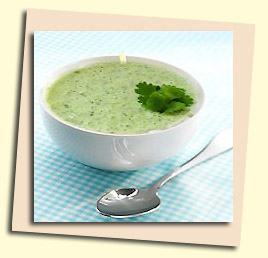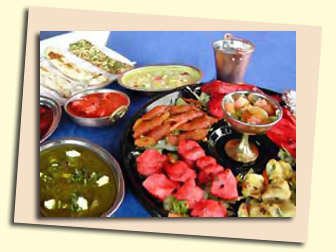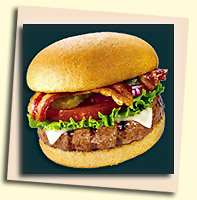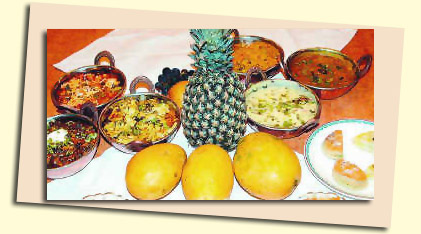Ayurveda Cooking - Ayurveda Food
|
|
|
|
Ayurveda Food |
|
|
|
Ayurveda Food |
|
Ayurveda provides a broad description of food and effect of food on
the body. The food is categorized according to its taste and Gunas
(the fundamental attributes). Ayurveda also classifies food on the
bases of doshas (body constitution) and seasons. It widely explains
which food item is favourable or unfavourable for an individual and
which food should be taken or avoided during particular season. Thus,
food is an elaborated subject of Ayurvedic cooking that holds
prominent importance in the whole process
Food
according to Gunas
There are three Gunas in Ayurveda Sattva, Rajas and Tamas. These gunas
are fundamental attributes that represent the natural evolutionary
process. These three gunas are presented in every human being with
more or less domination. An important way to regulate these gunas in
body and mind is ayurvedic cooking or food. On the bases of these
three gunas food can be classified as Sattvic, Rajasik, and Tamsik.
Sattvic Food |
 |
|
|
Sattvic food
is most simple and easiest to digest type of food. The food contains most
of its nutritional values as it is cooked by using minimal heat and modest
processing. It provides the necessary energy to the body without taxing
it. It is also considered as a foundation of higher states of
consciousness, that is why saints and seers survive on sattvic foods.
Sattvic food should be taken fresh or immediately after it is prepared.
Fresh juicy
fruits, vegetables (that are easily digestible), milk and milk products,
whole soaked or also sprouted beans, grains and nuts, many herbs and
spices consumed in their natural and near-natural forms are good examples
of satvik food. Common spices like ginger, turmeric, coriander, cardamom,
cinnamon, and aniseed are highly recommended in Sattvic diet while the
vegetables like onion, garlic, red chilies and black pepper and such other
pungent and astringent spices are forbidden. |
|
|
|
Cow’s
milk - the most Sattvic Food |
|
Cow’s milk is
regarded as the most complete, nourishing, and sattvic among all sattvic
food. Though buffalo milk is also used widely, it is not considered to be
as nourishing, and is usually not form the part of a sattvic diet. In the
absence of cow’s milk, goat’s milk is recommended as a substitute. An
exclusive body of work of Ayurveda deals with the benefits of cow’s milk
and explains guidelines for taking care of cows. Milk products like
butter, ghee (cooked and dehydrated butter) also used prominently in
sattvic diet as they are prepared with very nominal amount of heat and
retain their sattvic qualities. |
| |
|
Benefits of Satvik Food |
|
Sattvic diet
is best for health and vitality. A person who eats sattvic food has an
ideal combination of physical, mental and emotional harmony. Sattvic food
increase person’s well-being, and inner peace. Such a person always
remained focused in his work, sleeps less and stays energized all day
long.
Sattvic food keeps the person disease and disorder free. Person having
sattvic food remains sensitive to the various nuances of his sensory
being. He/she is less affected by exposure to adverse conditions. Even if
he/she falls sick, the recovery is very fast.
Person
having sattvic diet is usually of a calm disposition. She/he is not
provoked easily and usually not aggressive in nature. |
| |
|
Rajasik Food |
 |
Rajasik
food is rich in flavour but heavy to digest. It is suitable for people
who do arduous physical work. Vegetables cooked in excess butter, with
spicy and strong flavoring agents, are typical example of rajasic
preparation. Cooked fresh, rajasic food is rich in nutrients with
minimum dilution with water. Such food is heavy on salt and sugar and
takes longer period to digest than sattvic food. It calls for extended
sleeping hours and is sexually stimulating. Sattvic foods that have
been fried in oil or cooked too much or eaten in excess, specific
foods and spices that are strongly exciting, bitter, pungent, hot and
dry are examples of rajasic food. A rajasic food eater is usually
aggressive and overflowing with energy as the rajasic food increase
the speed and excitement of the human organism. According to Ayurveda
this energy can be beneficial if used wisely, it can lead a person
towards prosperity, power and prestige. A person
lives on a rajasic diet, has love for life and all the worldly pleasures.
|
|
|
Rajasic food is the foundation of motion, activity and pain hence rajasic
person has the capacity to suffer the pains, as well as the trials and
tribulations of life.comparison to a sattvic person, rajasic person would
lead an eventful but shorter life. He/she would be a good worldly being,
while a sattvic person is more focused on exploring life beyond physical
pleasures. |
| |
|
Tamasic
Food |
|
Tamsic food is considered the worst among all types of food. Dry,
unnatural, overcooked, stale, decaying and processed food makes for a
Tamasic diet. Tamaasic diet consumes a large amount of energy while
being digested. Refined food - be it cereals, oils or hydrogenated
butter, stimulants and beverages like tea, coffee and soft drinks,
fast and ready-to-cook food, canned or frozen food, precooked and
warmed food items like burgers, pizzas, pastries, and chocolates,
incompatible food as well as intoxicants like tobacco and alcohol are
tamasic examples of tamasic food.
Tamasic
diet is foundation of ignorance, doubt, pessimism and leads a person
to sick and painful life. A tamasic person always at serious
discomfort with himself and forgets to lead healthy a happy life.
Ayurveda suggests that a householder that live in the world and need
to keep pace with its' changes should include both the sattvic and
rajasic food in his/her diet. One can lead a long and healthy life by
having a balance diet which includes sattvic and rajasic foods.
Tamasic foods must be avoided as much as possible. |
 |
|
| |
|
Food
according to Tastes |
|
According to Ayurveda, taste is considerable element in cooking as taste
of each food or herb has specific physiological effects. There are six
major tastes in Ayurveda that have specific qualities and effects on body.
A balanced diet should involves all the six tastes in every meal or at
least have them once everyday. |
| |
| The
six tastes are |
 |
Sweet or Madhura
– Sweet foods have earth and water elements and usually sattvic gunas.
These are good for vata and pitta person as they subdued these doshas
while kapha person should avoid sweet foods as they increase it. In
general, sweet foods are nourishing, cool, moisturizing, and increase
weight.
Sour or Amla
–
Sour foods have
earth and fire elements and usually Rajasic gunas. Such foods are good
for vata people as they subdued this dosha. Pitta and kapha person
should avoid sour foods as they increase these doshas. In general,
sour foods are warm, oily and increase weight.
|
|
|
Salty or Lavan –
Salty
foods have water and fire elements and usually Rajasic gunas. Good for
vata people as they subdued this dosha, salty fods should be avoided
by pitta and kapha person as they increase these doshas. In general,
salty foods are warm, dissolving, stimulating, softening, oily, and
increase weight.
Pungent or Katu –
Pungent
foods have air and fire elements and could be Rajasic or Tamasic. They are
good for kapha person because they subdued this dosha but should be
avoided by vata and pitta persons as these doshas increased with such
foods. In general, pungent foods are warm, dry, stimulating, and decrease
weight.
Bitter or Tikta –
Bitter foods have air
and ether elements and usually Rajasic gunas. These are good for pitta and
kapha person as they subdued these doshas while vata person should avoid
such foods as they increase it. In general, bitter foods are cool, dry,
purifying and decrease weight.
Astringent or Kasaya -
Astringent foods have
air and earth elements and Rajasic gunas. These are good for pitta and
kapha person as they subdued these doshas while vata person should avoid
such foods as they increase it. In general, astringent foods are cool,
dry, and reduce stickiness.
|
| |
|
Food according to
Doshas |
|
Ayurveda consider each person as an individual with different composition
and needs. There are five basic elements in Ayurveda air, water, earth,
fire and ether that forms three basic doshas. each individual has his/her
own composition of these elements which determines his/her dominant dosha.
Thus every individual requires different diet according to the dominant
dosha. A food, which is beneficial for one, could be detrimental for
another. For example, Vata is a cold dry dosha, hence person with Vata as
predominant dosha need warm, nourishing foods, while the Pitta person
requires cool food to balance his fire element. |
| |
|
Pitta Dosha |
|
and overeating are the main causes that trouble pitta, hence such food
items should be reduced. Instead starchy foods such as vegetables, grains
and beans, salad, milk and ice cream should be included in the diet.
Alcoholic and fermented foods should also be avoided. Pitta person should
not take coffee also as the acid in the coffee is also pitta aggravating,
instead they can have herb teas like mint, licorice root or other that
pacify pitta.
If you have a mixed body constitution lik,
pitta-vata or pitta-kapha, then you should include portion for the second
influential dosha also. |
| |
|
List of favorable food
items |
|
Vegetables |
Fruits |
Grains |
Dairy |
Meat |
Oil |
Beverages |
Nuts & Seeds |
Herbs &
Spices |
|
Asparagus
Broccoli
Brussels sprouts
Cabbage
Cauliflower
Celery
Cucumber
Green
beans
Green (sweet) peppers
Leafy green vegetables
Lettuce
Mushrooms
Parsley
Peas
Potatoes
Sprouts
Squash
Zucchini |
Apples
Avocados
Cherries
Coconut
Figs
Dark grapes
Mangoes
Melons
Oranges
Pears
Pineapples
Plums
Prunes
Raisins |
Barley
Oats
Wheat
White rice (prefer basmati rice) |
Butter
Egg whites
Ghee (clarified butter )- unless you are watching cholesterol
Ice cream
Milk |
Chicken
Shrimp
Turkey
(All in small amounts) |
Coconut
Olive
Soy
Sunflower |
Almond milk
aloe vera juice
apple juice apricot juice berry juice black tea
chai (hot, spiced milk) cherry juice
cool dairy drinks
grain "coffee" grape juice
mango juice mixed veg. juice
orange juice
peach nectar pomegranate juice
prune juice pear juice
rice milk
soy milk |
Coconut
Pumpkin seeds
Sunflower seeds |
Spices are
generally avoided as too heating. In small amounts, the following
sweet and astringent spices are OK Cardamom
Cilantro(green coriander)
Cinnamon
Coriander seed
Dill
Fennel
Mint
Saffron
Turmeric
Plus small
amounts of cumin and black pepper |
|
| |
| |
|
List of unfavorable food items |
|
|
Vegetables |
Fruits |
Grains |
Dairy |
Meat |
Oil |
Beverages |
Nuts & Seeds |
Herbs&
Spices |
|
Beets
Carrots
Eggplant
Garlic
Hot peppers
Onions
Radishes
Spinach
Tomatoes |
Apricots
Bananas
Berries
Cherries (sour)
Cranberries
Grapefruit
Papayas
Peaches
Persimmons |
Brown rice
Corn
Millet
Rye |
Buttermilk
Cheese
Egg yolks
Sour cream
Yogurt |
Red meat and sea
food in general |
Almond
Corn
Safflower
Sesame
|
Apple cider berry
juice (sour) caffeinated beverages carbonated drinks carrot juice
cherry juice (sour) chocolate milk
coffee cranberry juice grapefruit juice
iced tea
iced drinks lemonade papaya juice tomato juice sour juices
|
All, except
mentioned above |
All pungent herbs
and spices, except as noted. Take only the minimal amounts of the
following: Barbecue sauce
Catsup
Mustard
Pickles
Salt
Sour salad dressings
Spicy condiments
Vinegar |
|
| |
| |
|
Kapha Dosha |
|
Kapha
is mainly water element thus influences the heavy, moist aspects of the
body. To keep kapha under balance warm, dry, light food cooked with less
water and minimum of fat is needed. One should increase the use of
pungent, bitter, and astringent tastes. Kapha people should consume
limited amount of sugar, oil and salt as well. Lightly cooked vegetables
and raw fruits and vegetables are more beneficial for kaphas.
Kapha people
usually have a tendency to overeating that should be controlled because it
lead to weight gain due to slow digestion.
Any spicy food
is good for kaphas such as very hot Mexican or Indian food, especially in
winter.
For kapha
types, breakfast is optional that means they can skip it they like. If
breakfast is taken it should be very light. They can have foods such as
hot-spiced cider, buckwheat pancakes with apple butter, corn muffins, and
bitter cocoa made with skim milk and a touch of honey. The main meal
should be at the middle of the day, and only a light, dry meal in the
evening is advisable. Kapha person can take honey, hot water, lemon juice
and ginger to energize themselves in the morning. Ginger tea can also be
taken. |
| |
| |
|
List of Favorable Food Items |
|
Vegetables |
Fruits |
Grains |
Dairy |
Meat |
Oil |
Beverages |
Nuts & Seeds |
Herbs
&
Spices |
|
Asparagus
beets
broccoli
Brussels sprouts
cabbage
carrots
cauliflower
celery
eggplant
garlic
leafy green vegetables
lettuce
mushrooms
okra
onions
peas
peppers
potatoes
radishes
spinach
sprouts |
Apples
apricots
berries
cherries
cranberries
figs
mangoes
peaches
pears
prunes
pomegranates
Dried fruits in
general are good for kapha. (apricots, figs, prunes, raisins)
|
Barley
buckwheat
corn
millet
oats, dry
rye
basmati rice |
Warm skim milk
small amounts of whole milk and eggs (not fried of cooked with butter) |
Chicken
shrimp
turkey
(All in small amounts) |
Almond
corn
safflower
sunflower
(All in small quantities) |
Aloe Vera juice
apple cider apple juice apricot juice berry juice black tea (spiced)
carob
carrot juice chai (hot spiced milk) cherry juice (sweet) cranberry
juice
grain "coffee" grape juice mango juice peach nectar pear juice
pinapple juice
pomegranate juice |
Sunflower seeds
pumpkin seeds |
All are good.
Ginger is especially good for improving digestion
|
|
| |
| |
|
List of
unfavorable Food Items |
|
Vegetables |
Fruits |
Grains |
Dairy |
Meat |
Oil |
Beverages |
Nuts &
Seeds |
Herbs
&
Spices |
|
Sweet and juicy
vegetables, such as:
cucumbers
sweet potatoes
tomatoes
zucchini |
Avocados
bananas
coconut
dates
fresh figs
grapefruit
grapes
melons
oranges
papayas
pineapples
plums
Avoid sweet, sour,
or very juicy fruits, in general.
|
Oats
rice
wheat, except in small amounts
Avoid hot cereals
and steamed grains, in general, as they are too moist and heavy for
kapha. |
All, except
mentioned above. |
Red meat
seafood in general |
All, except
mentioned above. |
Almond milk
caffeinated beverages carbonated drinks cherry juice (sour) chocolate
milk
coffee
cold dairy drinks grapefruit juice
iced tea
icy cold drinks lemonade orange juice
papaya juice rice milk
sour juices soy milk (cold)
tomato juice |
All, except
sunflower seeds and pumpkin seeds |
salt |
|
| |
| |
|
Vata Dosha |
|
such
foods are good for settling disturbed Vata. Food items such as warm milk,
cream, butter, warm soups, stews, hot cereals, fresh baked bread, ripe
fruits, salted nuts are good for vata. Breakfast is very important for
vata people. They can add hot cereals such as cream of rice or wheat, any
warm, milky, and sweet food item in their breakfast. Vata person should
avoid high caffeine drinks instead of them they can opt herbal teas. Spicy
Mexican or Indian foods that are cooked in oil also good for vata people.
On the other hand cold foods such as cold salads, iced drinks, raw
vegetables and greens are not very good for persons
with vata imbalance. They should avoid eating candies, dry fruits, and
unripe fruits. |
| |
|
List of Favorable Food Items |
|
Vegetables |
Fruits |
Grains |
Dairy |
Meat |
Oil |
Beverages |
Nuts & Seeds |
Herbs & Spices |
|
Asparagus
beets
carrots
cucumber
garlic
green beans
onions, cooked
onions, cooked
sweet potato
radishes
turnips
leafy greens in moderation |
Sweet fruits
apricots
avocados
bananas
berries
cherries
coconut
grapefruit
lemons
grapes
mangos
sweet melons
sour oranges
papaya
pineapple
peaches
plums
sour fruits
Stewed fruits
Sweet, well-ripened fruit in general |
Rice, wheat,
quinoa, oats, amaranth, all cooked until tender |
Whole milk, cream,
butter, fresh yogurt (cooked into foods), lassi, cottage cheese, fresh
paneer cheese |
Chicken
seafood, in general
turkey
All in small quantity |
All oils
are acceptable
Ghee, olive oil, sesame oil, cold-pressed nut oils such as walnut |
Almond Milk
Apple Cider
Apricot Juice
Berry Juice (except for cranberry)
Carob
Carrot Juice
Chai (hot spiced milk)
Cherry Juice
Lemonade
Mango Juice
Orange Juice
Papaya Juice
Peach Nectar
Pineapple Juice
Rice Milk
Sour Juices
Soy Milk (hot & well-spiced) |
Almonds (soaked
and blanched), cashews, walnuts (soaked), pistachios, hazelnuts,
pecans (soaked), pine nuts, sesame seeds, sunflower seeds, pumpkin
seeds. |
Ajwain, dried
ginger, asafetida (hing) in small quantities, fenugreek, turmeric,
cumin, clove, cardamom, coriander, fennel, black pepper, basil,
Chinese cinnamon, nutmeg, mustard seed, mint, rosemary, thyme, lemon
and orange zest, oregano, rock salt or sea salt, black salt, dried
mango powder, pomegranate seeds or powder |
|
| |
| |
|
List of Unfavorable Food
Items |
|
Vegetables |
Fruits |
Grains |
Dairy |
Meat |
Oil |
Beverages |
Nuts & Seeds |
Herbs & Spices |
|
Broccoli
Brussels sprouts
cabbage
cauliflower
celery
eggplant
leafy green vegetables
mushrooms
peas
peppers
potatoes
sprouts
tomatoes
zucchini |
Apples (raw)
Cranberries
Dates (dry)
Figs (dry)
Pomegranates
Prunes (dry)
Raisins (dry)
Watermelon
Unripe fruits, especially bananas.
|
Barley
buckwheat
corn
dry oats
millet
rye
Couscous
Crackers
Granola
Muesli
Pasta
Polenta
Rice Cakes
Rye
Sago
Spelt
Tapioca
Wheat Bran |
Cow’s Milk
(powdered)
Goat’s Milk (powdered)
Yogurt (plain, frozen or with fruits) |
Red meat |
Flaxseed
|
Apple Juice
Black Tea
Caffeinated Beverages
Carbonated Drinks
Chocolate Milk
Coffee
Cold Dairy Drinks
Cranberry Juice
Ice Cold Drinks
Mixed Veg. juice
Pear Juice
Pomegranate Juice
Prune Juice
Soy Milk (cold) |
No restriction |
Caraway |
|
| |
| |
|
Ayurveda Cooking and the Seasons |
|
According to Ayurveda with the changes in season our body needs different
foods to adjust itself to the outside environment. Every season brings
about nurturing qualities and the body needs plug into the nature for
rejuvenation. The main role of food is helping the body to maintain its
normal temperature. As the outer temperature swings with season, our body
needs energy to maintain its own temperature. For example, summer is hot
season when temperature rises and our body need cool foods to subdued
heat. Ayurveda further explains the relation between season and doshas and
recommend foods accordingly. Summer is a pitta season, in which
individuals are prone to sunburn, acne etc, so cool, light fruits and
salads are recommended to pacify the pitta imbalances. Winter is a vata
season and cold, arthritis, rheumatism etc are more likely to occur,
so Ayurveda recommends warm, oily and hearty meals like beans, whole
grains and meats to lubricate the system against dryness of Vata season.
Spring, which is a kapha season, increase the chances for bronchial
ailments and common colds etc, hence honey, millet and greens are advised
for season to dry the body of the mucus. |
| |
|
Common Tips for Healthy Food |
|
 Use organic
foods as much as possible. Use organic
foods as much as possible.
 Avoid
frozen, canned, processed, and genetically modified foods. Avoid
frozen, canned, processed, and genetically modified foods.
 Avoid
consuming fake foods which have small nutritional value, refined white
flour, white sugar, margarine, preservatives, artificial Avoid
consuming fake foods which have small nutritional value, refined white
flour, white sugar, margarine, preservatives, artificial
flavors, and colors.
 Avoid
leftovers, either cold out of the refrigerator, or reheated. Avoid
leftovers, either cold out of the refrigerator, or reheated.
 Cook foods
slowly, on a lower heat, and avoid microwave. Cook foods
slowly, on a lower heat, and avoid microwave.
 Use fresh,
ripe fruits and veggies. Use fresh,
ripe fruits and veggies.
 Eat fresh
food that is freshly prepared. Eat fresh
food that is freshly prepared.
 Add a wide
variety of seasonal, wholesome foods in your daily diet. Add a wide
variety of seasonal, wholesome foods in your daily diet.
 Choose
foods according to the season, your specific imbalance and Ayurvedic body
type. Choose
foods according to the season, your specific imbalance and Ayurvedic body
type. |
| |
|
|
| |
|
|







